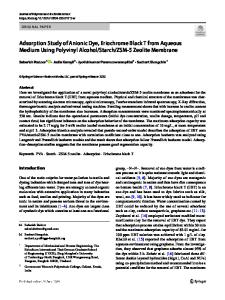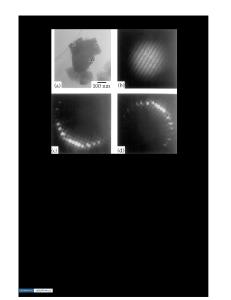Effect of poly(acrylic acid) and poly(vinyl alcohol) on the solubility of colloidal BaTiO 3 in an aqueous medium
- PDF / 153,855 Bytes
- 9 Pages / 612 x 792 pts (letter) Page_size
- 101 Downloads / 285 Views
Vincent A. Hackley Materials Science & Engineering Laboratory, National Institute of Standards and Technology, Gaithersburg, Maryland 20899-8520
Jaeho Lee and Sangkyu Lee Department of Ceramic Engineering, Hanyang University, Seoul 133-791, Korea (Received 24 November 2002; accepted 28 February 2003)
The influence of poly(acrylic acid) (PAA) and poly(vinyl alcohol) (PVA) on Ba dissolution from the BaTiO3-aqueous solution interface was investigated. Incongruent dissolution of Ba impacts the colloidal stability, microstructure, and electrical properties of BaTiO3 and related perovskite dielectric materials used in the manufacture of ceramic capacitors. The solubility characteristics of BaTiO3 were influenced significantly by the presence of PAA and PVA. PAA, which forms weak monodentate complexes with Ba2+, acted as both a passivating and a sequestering agent, depending on pH. Both PAA and PVA provided some degree of passivation in the acidic pH region. Above pH 8, where BaTiO3 solubility decreases sharply, PVA had a moderate passivating effect, whereas solubility was enhanced by PAA with a positive linear dependence on concentration. The adsorptive and electrokinetic behavior of colloidal BaTiO3 with respect to PAA and PVA are correlated with the observed passivating and sequestering properties of these polymers.
I. INTRODUCTION
Barium titanate is used extensively as a starting material in the fabrication of Y5V and X7R multilayer ceramic capacitors (MLCCs) because of its excellent dielectric properties.1–3 In general, the dielectric layers in MLCCs are fabricated by the doctor blade tape casting method.4 Although solvent-based ceramic slurries have been traditionally used, there has been a recent push toward aqueous-based tape casting for cost-related and environmental benefits. However, a critical difficulty associated with aqueous-based systems is the incongruent dissolution of BaTiO3 and the resulting accumulation of Ba2+ in solution; this effect is accelerated in acidic media due to thermodynamic instabilities.5–9 As recent investigations have shown,10,11 the dispersion stability of colloidal BaTiO3 is closely tied to changes in the surface chemistry that result from leaching of Ba2+ ions. Dispersion stability has a critical impact on particle packing,12 which in turn influences the microstructure and electrical properties of the sintered dielectric layer.13 An increase in dielectric layer permittivity of MLCCs can be achieved by decreasing the sheet thickness and increasing the stacking layers. As the particle size is reduced to 1266
http://journals.cambridge.org
J. Mater. Res., Vol. 18, No. 5, May 2003 Downloaded: 24 Mar 2015
achieve thinner sheets, agglomeration, which can degrade packing density, becomes a considerable issue in wet processing. In addition, the dielectric and microstructural properties of BaTiO3 are very sensitive to stoichiometry, and small deviations may cause significant deterioration or enhancement of the dielectric response. Ti excess has been reported to cause exaggerated grain
Data Loading...











